
A legendary Retreat
That’s a name that will probably stays forever with a bitter-sweet taste for the British public and collective imagination, but its memory is still vivid after many documentaries and two movies (the first 1958) like Christopher Nolan’s Dunkirk. The name of the last harbor this side of the channel, pocket of resistance for the bulk of the defeated British and French Armies. Hope in despair.

Isle of Man steam ferry SS Mona’s Queen sinking after striking a mine off Dunkirk, 29 May 1940
And the the extraordinary mobilization of both the military, ground troops doing rearguard fighting, both navies loosing about 12 destroyers in the process, the Air Force, trying to contain the Luftwaffe, civilians volunteering to get the men out despite the odds, and finally the controversial “good will” gesture of Hitler that kept Panzers out of the perimeter to the last minute. This all combined for the “miracle of Dunkirk” allowing to carry back to UK far more British troops, the BEF being the cream of the small Professional British Army, and many thousand Frenchmen fighting a brave rearguard action in the outskirt of the city. As Churchill stated “a war is not won by evacuations”.
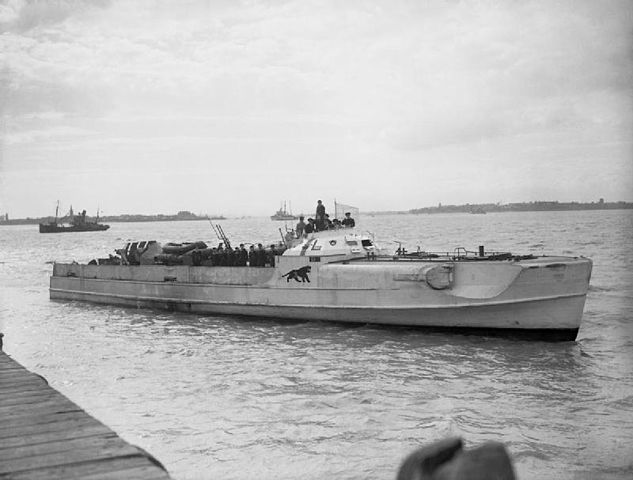
German E-Boote (British designation) or Schnellboot. They had a range of 800 nmi (1,500 km; 920 mi) at 30 knots (56 km/h; 35 mph). Larger German R-Boote (Räumboote) or fast minelayers/minesweepers would later rampage through the Channel. There are countless reports of allied ships sunk by torpedoes and mines, yet Kriegsmarine actions between a costly Norwegian campaign and the aborted late summer invasion (Operation Sea Lion) are yet to fully unfold. At least Bourrasque is recorded to have been sunk by E-boats S-23 and S-26 on 31 May, Wakeful by S-30 on 29 May, and Grafton by U-29 the same day.
*As a personal note i would add Dunkirk touches me in a very personal way. My father was born there, carried away under bombs. Still family on this side resides here. Spent a sizeable part of my childhood there, in front of these very beaches. My father played as a kid with none-exploded ammunitions, found numerous bones, and ventured in and around rusting hulks like the destroyed Bourrasque that laid there for some time before demolition.
My grandfather worked for a shipping company here, and my great-grandfather was a great banks schooner captain, also operating from Dunkirk. Needless to say we both saw Nolan’s eponymous movie two weeks ago. Overall a great movie, with a single odd detail about one filmed area included at the beginning in street fighting that was actually filmed in Bray-Dunes, not Dunkirk.
Premices of the campaign
When the Norway theatre seems sold, much of the international attention shifted away from Scandinavia, as Norway and Denmark were occupied by the Germans, Sweden remaining neutral, and Finland was partly dismembered by the USSR after a rough winter campaign. The western front suddenly exploded in May 1940, with the invasion of the Netherlands and Belgium. This pincer movement of the Wehrmacht, the awaited thrust to the north being supported by a surprise onslaught from the Ardennes, trapping near a Million men, were the best allies has to offer. On May 20, Heinz Guderian’s panzers reached Abbeville, closing the trap.

One of the largest losses after the campaign was Cunard’s SS Lancastria, sunk off St Nazaire on June, 17, 1940, in Operation Ariel* (see below)
Allied forces retreated, bombarded by the Luftwaffe on roads still encumbered with civilians, to the only major port in the Pas de Calais: Dunkirk. It could be translated as the “church in the dunes” in Flemish. Dunkirk was already famous in 1914-1918, by its strategic position in the North Sea. Weygand was in favor of a large counter-attack at Arras so that his forces heading south could make their junction with the still preserved divisions, but Lord Gort opposed him and quickly receives the assent of the war cabinet. It was on May 26, that the decision fell, that an evacuation was decided from Dunkirk.
Operation Dynamo
This encirclement continued around Dunkirk pocket, where the Admiralty envisaged a bold but extremely risky evacuation plan, the Dynamo plan. The brain of this operation, dubbed “Dynamo” was Admiral Ramsay. In a few days he committed the Royal Navy and in June, he mobilized literally everything that could float to be sent to the English Channel. But neither the Kriegsmarine nor the Luftwaffe remained impassive. While on the ground the pressure increased, seven German divisions were held at a distance by the 30,000 French soldiers of General Molinier, encircled near Lille by Rommel, who protected this operation, fighting for four days until the last cartridge. The suburbs of the city were to assaulted by panzergrenadiers, while Goering made great efforts to annihilate the pocket of Dunkirk by the air, effectively destroying ships at the wharf, preventing troops to be evacuated any other way but the beach.
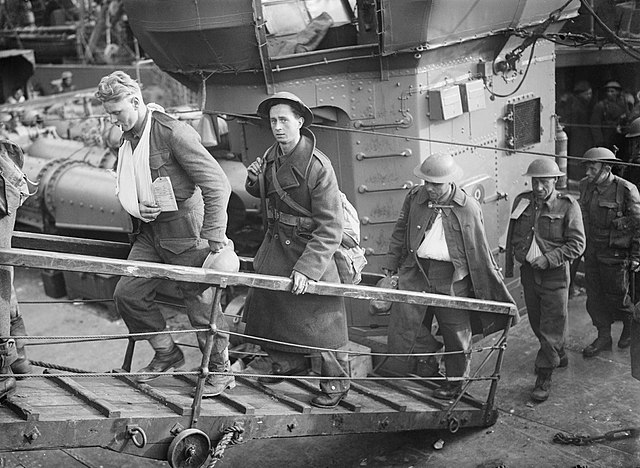
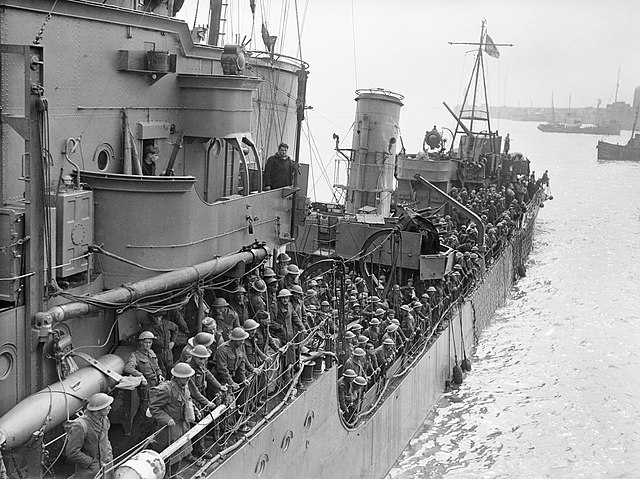
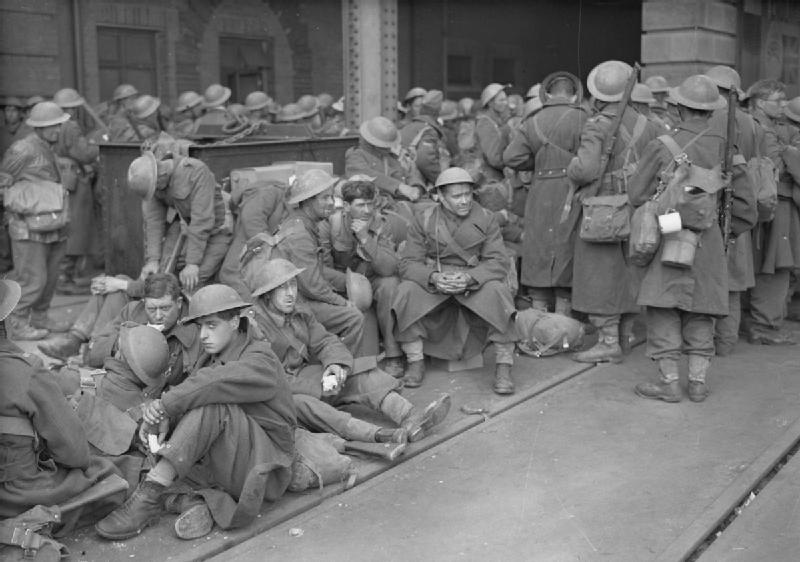
Evacuation of British troops (cc)
Hitler’s unexpected respite
In the midst of this terrible retreat, an unexpected respite came from the Fuhrer himself, through the intermediary of General-in-Chief Von Runstedt.
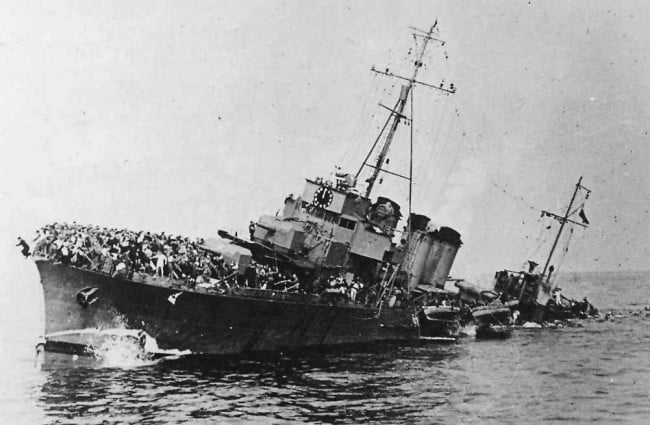
Famous photo of the Bourrasque, sunk at Dunkirk. The French lost four destroyers, the British seven.
Debates and controversy still rages about this decision. For some the latter was indeed anxious about Guderian’s race to the sea and possible flank counterattacks, more concerned about the capture of Paris. For others he wanted to spare the British for signing a possible truth. This respite allowed sleepless German troops running on pervitine to rest while waiting for the arrival of the fuel, and the allies to establish a real evacuation corridor between Lille and Dunkirk, still under the threat of the Luftwaffe. The decision was wildly criticized among Wehrmacht officers themselves.
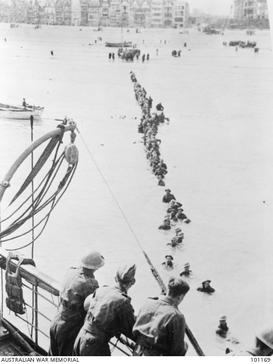
Soldier waiting in line to be carried
But this town is preparing for the 25th of May, when the “Battle of Dunkirk” is about to take place, to live the worst moment of its history. The British Admiralty, under the direction of Vice-Admiral Ramsay, and under the urging of Lord Gort, is developing a rescue and evacuation operation that is still unprecedented in history: It will be Dynamo. It is a matter of saving, in the absence of material, abandoned for lack of time and priority, men, starting with 300,000 strong British Expeditionary Force, the blossom of the army and empire. By saving the “Tommies”, by all means, Ramsay and Churchill prepared the mainland to repel a future invasion.
Famous photo showing a Tommie trying to fire on a strafing German plane

British destroyer HMS Keith, sunk at Dunkirk, like HMS Basilisk, Wakeful, Grenade, Havant.
And there is another difficulty: The port of Dunkirk had a limited capacity and only two serviceable jetties, and soon the Luftwaffe sow death and destruction: On May 28, a massive first raid of 400 aircraft, among which 180 Stukas transforms the Port in living hell. The day after, 400 bombers protected by 180 Me109 went one, sinking a freighter that would crush the city water supply at the bottom.
The huge oil tanks went ablaze and an acrid “night” envelops the city for several days, ironically preventing the Luftwaffe to perform other operations than limited strafing. Jetties were soon crowded, freighter sunk in the harbor blocked approaches and only the wooden eastern mole remains free, while the bulk of the troops had to embark from the beaches, and to cross miles of shallow water and swim to large vessels expected. In fact most had to content themselves with waiting offshore for a number of small boats to commute (from June 1st). Among these were improbable ships like paddle steamers, a fire boat, and a Thames River “sludge hopper”.

British troops trying to defend against screeming Stukas diving, conveying some idea of the chaos (Feature film re-enactment)
Soon the very large Atlantic beaches of Dunkirk, once a famous holiday’s resort, went cluttered with columns of tired, hungry and thirsty men advancing in the water up to their necks to access ships under Stukas’s relentless strafing and the clatter of artillery brought round the perimeter from the city. The defense was assured by the rear guard of the French all along. The latter had almost 500,000 men at the beginning, but less than 123,000 would take their chance through the channel, with 35,000 remaining behind. Churchill insisted that on June 3, to try to save the French rear-guard, hoping the French will continue the fight.
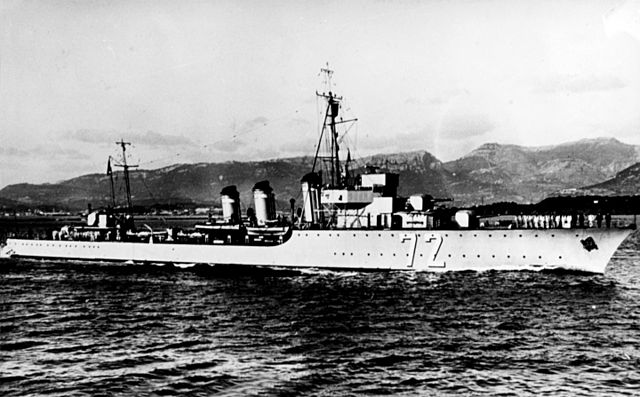
French destroyer Le Foudroyant, sunk at Dunkirk
In spite of the efforts of the RAF, limited in range (they could only operate one hour over Dunkirk, and many rarely ventured above the beaches, having spent their supply in dogfight at sea in between). The RAF lost 145 planes downed in nine days of fighting. It has been less spared than destroyers of the Royal Navy, for which clear orders had been passed at some point. The Luftwaffe had almost hands free and caused a carnage: Of the 39 British destroyers dispatched on the spot (and later withdrawn), six are sunk, for a dozen in all including four for the French, who lost as of the 27th the Sirroco and the Jaguar.
Losses were heavier for freighters and ferries, but precisely the swarm of hundreds of light units dispatched on the spot, yachts, trawlers, ferries, barges, sometimes simple rowboats, maneuvered by courageous civilians were spared precisely because of their size and could approach the beaches and carry out men in droves. Their contribution was more symbolic than other ships as they had been only informed on may 31, 18h00, and saved 26 500 men or less than 10% of the total. In all perhaps 1200 boats and ships participated in the bulk of the evacuation the last days.
Operation Dynamo extended itself for 9 days, ending on 4 June in the middle of the night, to complete the evacuation of the British, and part of the French, who remained in the rear to defend the perimeter Of Dunkirk until there was nothing more to do. 75,000 were to be evacuated after the last Tommy was out, but 35,000 of them left behind would surrender on June 4 after 11 am, with the arrival of the panzergrenadiers who fought house by house and captured the remaining center of the city. These men, headed by General Beaufrere would be sent to Germany in the camps and some later returned to France, while those among the evacuees did so later at the demand of a government now in peace with Germany.
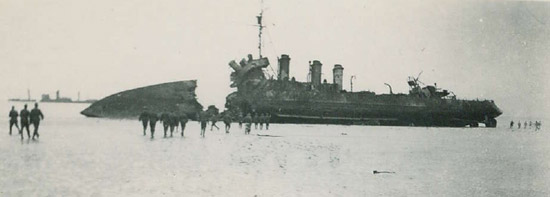
Franch Destroyer l’Adroit, sank in front of Dunkirk, Malo les Bains. She was scrapped in the 1950s.
Only a small fraction would stay and constitute the initial core of the Free French. It should be mentioned that the French Army there deployed colonial troops from Morocco and Algeria, Tunisia made a sizeable part of those left behind to defend the perimeter (like the 8e régiment de zouaves). There was also on the British side a small detachment of Canadian troops but also Indian auxiliaries at Dunkirk. Not known is also the story of 29 Dutch trawlers and coasters fleeing German occupation that also helped evacuating 23 000 troops making several trips and loosing seven ships.

RMS Lady of Mann, which evacuated thousands. This 1930 ship operated for the Isle of Man Steam Packet Company at Barrow-in-Furness.
For the French the episode would retain a certain bitterness for those “guarding the back” to be left behind, and lack of communication at some point with Admiral Abrial ensured a sense of “treason”, hoping until then the British were just moving their troops in another theater of operation like Britanny. Weygand and others from the general staff would also accuse Gort’s last move to wreck the Arras counterstroke. The alliance was definitely broken at the conference of Briare when Churchill announced his refusal to commit the RAF for a battle of France he estimated lost and in August operation “catapult” would certainly fuel a resentment (well fed by German propaganda) that durably hampered efforts of De Gaulle to recruit for his Free French Army in exile (only 3,000 would join from the men rescued at Dunkirk).
All in all, 9 destroyers has been sunk, 19 more damaged, 200 other ships, small crafts and boats sunk and about 200 damaged. Ground-wise, the British lost 68,000 BEF troops, with over 6500 killed, 13,000 wounded, 2,472 guns, 20,000 motorcycles and 65,000 other vehicles, 416,000 tons of stores, including 68,000 of ammunition and 162,000 of fuel and nearly all of the 445 tanks committed.

An aerial reconstitution of the bombings of Dunkirk by the Luftwaffe
Dunkirk, however, remained a pivot point -alternative scenario with the complete BEF killed or captured would have significantly weakened British resolve and/or perhaps add grave consequence above the rest of the war, particularly in Africa and the Suez canal.
This was however seen as a victory, 365,675 men being evacuated instead of the 50,000 originally planned, although Churchill, lucid, said at the time (“wars are not won with evacuations”). This became a watchword for all the British soldiers engaged (remember Dunkirk), especially on D-Day in June 1944. Although carried out with total improvisation and phlegm, this evacuation marked the end of all organized military resistance in continental Western Europe, announcing heavy clouds for the future. However “Dunkirk spirit” would made a lot to smith British resolve, personified by Churchill’s arguably most famous speech at Parliament on June 4, 1940 “we shall fight on the beaches…”
Forgotten evacuations: Operation Cycle & Ariel (10-25 june)
Many could think after Dunkirk all allies troops still remaining on the continent were trapped. Nothing could be further form the truth. Dynamo was indeed followed by Operation Cycle, an evacuation from Le Havre on 10-13 june. This helped evacuating part of the Highlanders (however over 6,000 Highlanders were taken prisoner on 12 June) and the French retreating to St Valery-en-Caux (Normandy).
Operation Ariel took place two weeks after Dynamo, where the remainder of British, French but also Polish and Czech forces still trapped at St Nazaire and Nantes were evacuated. Troops were also evacuated on the Atlantic coast from (north to south) Cherbourg, St Malo, Brest, La Pallice, Bordeaux, and Bayonne. This was fortunately not always under threat of the Luftwaffe. In all this represented another 191,870 troops.
Operation Ariel will saw one of the most vivid tragedies with the sinking of SS Lancastria. The 1920, 16,243 GRT liner operated by Cunard embarked between 5000 and 9000 civilians when it was attacked by Junkers Ju 88 aircraft from II. Gruppe/Kampfgeschwader 30. Some 1200 tons leaking fuel would transform the scene into a raging inferno, and those not burned and drowned were killed by strafing planes. 2,477 were saved however.
Sources/read more
www.historytoday.com/patrick-wilson/dunkirk-victory-or-defeat
British Equipments lost at Dunkirk
Evacuation of dunkirk in colour
Facts about Dunkirk – BBC Stats
About the soldiers left behind
wikipedia.org/wiki/List_of_Royal_Navy_losses_in_World_War_II
en.wikipedia.org/wiki/Battle_of_Dunkirk
wikipedia.org/wiki/Operation_Ariel
wikipedia.org/wiki/Operation_Cycle
Video
Dunkirk War Drama 1958 John Mills
For the French side of the events, see also Henri Verneuil’s 1964 Week end at Dunkirk.



 Latest Facebook Entry -
Latest Facebook Entry -  X(Tweeter) Naval Encyclopedia's deck archive
X(Tweeter) Naval Encyclopedia's deck archive Instagram (@navalencyc)
Instagram (@navalencyc)





 French Navy
French Navy Royal Navy
Royal Navy Russian Navy
Russian Navy Armada Espanola
Armada Espanola Austrian Navy
Austrian Navy K.u.K. Kriegsmarine
K.u.K. Kriegsmarine Dansk Marine
Dansk Marine Nautiko Hellenon
Nautiko Hellenon Koninklije Marine 1870
Koninklije Marine 1870 Marinha do Brasil
Marinha do Brasil Osmanlı Donanması
Osmanlı Donanması Marina Do Peru
Marina Do Peru Marinha do Portugal
Marinha do Portugal Regia Marina 1870
Regia Marina 1870 Nihhon Kaigun 1870
Nihhon Kaigun 1870 Preußische Marine 1870
Preußische Marine 1870 Russkiy Flot 1870
Russkiy Flot 1870 Svenska marinen
Svenska marinen Søværnet
Søværnet Union Navy
Union Navy Confederate Navy
Confederate Navy Armada de Argentina
Armada de Argentina Imperial Chinese Navy
Imperial Chinese Navy Marinha do Portugal
Marinha do Portugal Mexico
Mexico Kaiserliche Marine
Kaiserliche Marine 1898 US Navy
1898 US Navy Sovietskiy Flot
Sovietskiy Flot Royal Canadian Navy
Royal Canadian Navy Royal Australian Navy
Royal Australian Navy RNZN Fleet
RNZN Fleet Chinese Navy 1937
Chinese Navy 1937 Kriegsmarine
Kriegsmarine Chilean Navy
Chilean Navy Danish Navy
Danish Navy Finnish Navy
Finnish Navy Hellenic Navy
Hellenic Navy Polish Navy
Polish Navy Romanian Navy
Romanian Navy Turkish Navy
Turkish Navy Royal Yugoslav Navy
Royal Yugoslav Navy Royal Thai Navy
Royal Thai Navy Minor Navies
Minor Navies Albania
Albania Austria
Austria Belgium
Belgium Columbia
Columbia Costa Rica
Costa Rica Cuba
Cuba Czechoslovakia
Czechoslovakia Dominican Republic
Dominican Republic Haiti
Haiti Hungary
Hungary Honduras
Honduras Estonia
Estonia Iceland
Iceland Eire
Eire Equador
Equador Iran
Iran Iraq
Iraq Latvia
Latvia Liberia
Liberia Lithuania
Lithuania Mandchukuo
Mandchukuo Morocco
Morocco Nicaragua
Nicaragua Persia
Persia San Salvador
San Salvador Sarawak
Sarawak Uruguay
Uruguay Venezuela
Venezuela Zanzibar
Zanzibar Warsaw Pact Navies
Warsaw Pact Navies Bulgaria
Bulgaria Hungary
Hungary

 Bundesmarine
Bundesmarine Dutch Navy
Dutch Navy Hellenic Navy
Hellenic Navy Marina Militare
Marina Militare Yugoslav Navy
Yugoslav Navy Chinese Navy
Chinese Navy Indian Navy
Indian Navy Indonesian Navy
Indonesian Navy JMSDF
JMSDF North Korean Navy
North Korean Navy Pakistani Navy
Pakistani Navy Philippines Navy
Philippines Navy ROKN
ROKN Rep. of Singapore Navy
Rep. of Singapore Navy Taiwanese Navy
Taiwanese Navy IDF Navy
IDF Navy Saudi Navy
Saudi Navy Royal New Zealand Navy
Royal New Zealand Navy Egyptian Navy
Egyptian Navy South African Navy
South African Navy






























 Ukrainian Navy
Ukrainian Navy dbodesign
dbodesign